Assessment of Iron Oxide (III)–Therminol 66 Nanofluid as a Novel Working Fluid in a Convective Radiator Heating System for Buildings
Abstract
:1. Introduction
2. Materials and Methods
2.1. Experimental Setup
2.2. Preparation of the Nanofluids, Stability Analysis, and Characterization
2.3. Nanofluids Properties
2.4. Data Analysis and Uncertainty Quantification
3. Results
3.1. Convective Heat Transfer Coefficient
3.2. Pressure Drop
3.3. Friction Factor
3.4. Temperature of the Tank
4. Conclusions
Author Contributions
Funding
Acknowledgments
Conflicts of Interest
References
- De Wilde, P.; Van Der Voorden, M. Providing computational support for the selection of energy saving building components. Energy Build. 2004, 36, 749–758. [Google Scholar] [CrossRef]
- Thormark, C. A low energy building in a life cycle—Its embodied energy, energy need for operation and recycling potential. Build. Environ. 2002, 37, 429–435. [Google Scholar] [CrossRef]
- Safaei, M.; Togun, H.; Vafai, K.; Kazi, S.; Badarudin, A. Investigation of heat transfer enhancement in a forward-facing contracting channel using FMWCNT nanofluids. Numer. Heat Transf. Part A Appl. 2014, 66, 1321–1340. [Google Scholar] [CrossRef]
- Goodarzi, M.; Amiri, A.; Goodarzi, M.S.; Safaei, M.R.; Karimipour, A.; Languri, E.M.; Dahari, M. Investigation of heat transfer and pressure drop of a counter flow corrugated plate heat exchanger using MWCNT based nanofluids. Int. Commun. Heat Mass Transf. 2015, 66, 172–179. [Google Scholar] [CrossRef]
- Akbari, O.A.; Toghraie, D.; Karimipour, A.; Safaei, M.R.; Goodarzi, M.; Alipour, H.; Dahari, M. Investigation of rib’s height effect on heat transfer and flow parameters of laminar water–Al2O3 nanofluid in a rib-microchannel. Appl. Math. Comput. 2016, 290, 135–153. [Google Scholar]
- Muraleedharan, M.; Singh, H.; Suresh, S.; Udayakumar, M. Directly absorbing Therminol-Al2O3 nano heat transfer fluid for linear solar concentrating collectors. Sol. Energy 2016, 137, 134–142. [Google Scholar] [CrossRef]
- Harandi, S.S.; Karimipour, A.; Afrand, M.; Akbari, M.; D’Orazio, A. An experimental study on thermal conductivity of F-MWCNTs–Fe3O4/EG hybrid nanofluid: Effects of temperature and concentration. Int. Commun. Heat Mass Transf. 2016, 76, 171–177. [Google Scholar] [CrossRef]
- Davarnejad, R.; Jamshidzadeh, M. CFD modeling of heat transfer performance of MgO-water nanofluid under turbulent flow. Eng. Sci. Technol. Int. J. 2015, 18, 536–542. [Google Scholar] [CrossRef]
- Moghaddam, M.A.; Motahari, K. Experimental investigation, sensitivity analysis and modeling of rheological behavior of MWCNT-CuO (30–70)/SAE40 hybrid nano-lubricant. Appl. Therm. Eng. 2017, 123, 1419–1433. [Google Scholar] [CrossRef]
- Motahari, K.; Moghaddam, M.A.; Moradian, M. Experimental investigation and development of new correlation for influences of temperature and concentration on dynamic viscosity of MWCNT-SiO2 (20-80)/20W50 hybrid nano-lubricant. Chin. J. Chem. Eng. 2018, 26, 152–158. [Google Scholar] [CrossRef]
- Hosseini, S.M.; Safaei, M.R.; Goodarzi, M.; Alrashed, A.A.; Nguyen, T.K. New temperature, interfacial shell dependent dimensionless model for thermal conductivity of nanofluids. Int. J. Heat Mass Transf. 2017, 114, 207–210. [Google Scholar] [CrossRef]
- Abdollahi-Moghaddam, M.; Motahari, K.; Rezaei, A. Performance characteristics of low concentrations of CuO/water nanofluids flowing through horizontal tube for energy efficiency purposes; an experimental study and ANN modeling. J. Mol. Liq. 2018, 271, 342–352. [Google Scholar] [CrossRef]
- Nikkhah, Z.; Karimipour, A.; Safaei, M.R.; Forghani-Tehrani, P.; Goodarzi, M.; Dahari, M.; Wongwises, S. Forced convective heat transfer of water/functionalized multi-walled carbon nanotube nanofluids in a microchannel with oscillating heat flux and slip boundary condition. Int. Commun. Heat Mass Transf. 2015, 68, 69–77. [Google Scholar] [CrossRef]
- Goodarzi, M.; Safaei, M.; Karimipour, A.; Hooman, K.; Dahari, M.; Kazi, S.; Sadeghinezhad, E. Comparison of the finite volume and lattice Boltzmann methods for solving natural convection heat transfer problems inside cavities and enclosures. Abstr. Appl. Anal. 2014. [Google Scholar] [CrossRef]
- Olia, H.; Torabi, M.; Bahiraei, M.; Ahmadi, M.H.; Goodarzi, M.; Safaei, M.R. Application of nanofluids in thermal performance enhancement of parabolic trough solar collector: State-of-the-art. Appl. Sci. 2019, 9, 463. [Google Scholar] [CrossRef]
- Persson, U.; Werner, S. Heat distribution and the future competitiveness of district heating. Appl. Energy 2011, 88, 568–576. [Google Scholar] [CrossRef]
- Brown, L.R. Eco-Economy: Building an Economy for the Earth; Routledge: Abingdon, UK, 2013. [Google Scholar]
- Kulkarni, D.P.; Das, D.K.; Vajjha, R.S. Application of nanofluids in heating buildings and reducing pollution. Appl. Energy 2009, 86, 2566–2573. [Google Scholar] [CrossRef]
- Park, K.-J.; Jung, D. Boiling heat transfer enhancement with carbon nanotubes for refrigerants used in building air-conditioning. Energy Build. 2007, 39, 1061–1064. [Google Scholar] [CrossRef]
- Kumar, R.R.; Sridhar, K.; Narasimha, M. Heat transfer enhancement in domestic refrigerator using R600a/mineral oil/nano-Al2O3 as working fluid. Int. J. Comput. Eng. Res. 2013, 3, 42–50. [Google Scholar]
- Firouzfar, E.; Soltanieh, M.; Noie, S.H.; Saidi, S.H. Energy saving in HVAC systems using nanofluid. Appl. Therm. Eng. 2011, 31, 1543–1545. [Google Scholar] [CrossRef]
- Hatami, M.; Domairry, G.; Mirzababaei, S. Experimental investigation of preparing and using the H2O based nanofluids in the heating process of HVAC system model. Int. J. Hydrogen Energy 2017, 42, 7820–7825. [Google Scholar] [CrossRef]
- Khalifa, A.H. Comparative Study for Heat Transfer Enhancement and Energy Saving in HVAC system using Nanoparticles. IJO Int. J. Appl. Sci. 2019, 2, 1–13. [Google Scholar]
- Canbolat, A.S.; Bademlioglu, A.H.; Kaynakli, O. Determination of proper insulation thickness for building walls regarding economic consideration. Int. Res. J. Adv. Eng. Sci. 2018, 4, 173–176. [Google Scholar]
- Berardi, U.; Nosrati, R.H. Long-term thermal conductivity of aerogel-enhanced insulating materials under different laboratory aging conditions. Energy 2018, 147, 1188–1202. [Google Scholar] [CrossRef]
- Shelote, K.; Jajodia, R.; Gavali, H.; Madurwar, M.; Gadve, S.; Ralegaonkar, R.V. Experimental and Computational Analysis of Energy Efficient Plaster. Proc. Sustain. Infrastruct. Dev. Manag. 2019. [Google Scholar] [CrossRef]
- Alam, M.; Singh, H.; Limbachiya, M. Vacuum Insulation Panels (VIPs) for building construction industry–A review of the contemporary developments and future directions. Appl. Energy 2011, 88, 3592–3602. [Google Scholar] [CrossRef]
- Cockroft, J.; Cowie, A.; Samuel, A.; Strachan, P. Potential energy savings achievable by zoned control of individual rooms in UK housing compared to standard central heating controls. Energy Build. 2017, 136, 1–11. [Google Scholar] [CrossRef]
- Yu, W.; France, D.M.; Choi, S.U.; Routbort, J.L. Review and Assessment of Nanofluid Technology for Transportation and Other Applications; Argonne National Lab. (ANL): Argonne, IL, USA, 2007. [Google Scholar]
- Colangelo, G.; Favale, E.; Miglietta, P.; Milanese, M.; de Risi, A. Thermal conductivity, viscosity and stability of Al2O3-diathermic oil nanofluids for solar energy systems. Energy 2016, 95, 124–136. [Google Scholar] [CrossRef]
- Colangelo, G.; Favale, E.; De Risi, A.; Laforgia, D. A new solution for reduced sedimentation flat panel solar thermal collector using nanofluids. Appl. Energy 2013, 111, 80–93. [Google Scholar] [CrossRef]
- Colangelo, G.; Favale, E.; Miglietta, P.; de Risi, A.; Milanese, M.; Laforgia, D. Experimental test of an innovative high concentration nanofluid solar collector. Appl. Energy 2015, 154, 874–881. [Google Scholar] [CrossRef]
- Choi, C.; Yoo, H.S.; Oh, J.M. Preparation and heat transfer properties of nanoparticle-in-transformer oil dispersions as advanced energy-efficient coolants. Curr. Appl. Phys. 2008, 8, 710–712. [Google Scholar] [CrossRef]
- Saeedinia, M.; Akhavan-Behabadi, M.A.; Nasr, M. Experimental study on heat transfer and pressure drop of nanofluid flow in a horizontal coiled wire inserted tube under constant heat flux. Exp. Therm. Fluid Sci. 2012, 36, 158–168. [Google Scholar] [CrossRef]
- Liu, M.-S.; Lin, M.C.-C.; Huang, I.T.; Wang, C.-C. Enhancement of thermal conductivity with carbon nanotube for nanofluids. Int. Commun. Heat Mass Transf. 2005, 32, 1202–1210. [Google Scholar] [CrossRef]
- Iacobazzi, F.; Milanese, M.; Colangelo, G.; de Risi, A. A critical analysis of clustering phenomenon in Al2O3 nanofluids. J. Therm. Anal. Calorim. 2019, 135, 371–377. [Google Scholar] [CrossRef]
- Mukherjee, S.; Paria, S. Preparation and stability of nanofluids-A Review. IOSR J. Mech. Civ. Eng. 2013, 9, 63–69. [Google Scholar] [CrossRef]
- Ghadimi, A.; Saidur, R.; Metselaar, H.S.C. A review of nanofluid stability properties and characterization in stationary conditions. Int. J. Heat Mass Transf. 2011, 54, 4051–4068. [Google Scholar] [CrossRef]
- Amiri, A.; Ahmadi, G.; Shanbedi, M.; Etemadi, M.; Zubir, M.N.M.; Chew, B.T.; Kazi, S.N. Heat transfer enhancement of water-based highly crumpled few-layer graphene nanofluids. RSC Adv. 2016, 6, 105508–105527. [Google Scholar] [CrossRef]
- Kline, S.J.; McClintock, F.A. Describing Uncertainties in Single-Sample Experiments. Mech. Eng. 1953, 75, 3–8. [Google Scholar]
- Carley, K.M.; Kamneva, N.Y.; Reminga, J. Response Surface Methodology: CASOS Technical Report; Center for Computational Analysis of Social and Organizational Systems, Carnegie Mellon University: Pittsburgh, PA, USA, 2004. [Google Scholar]
- Vallejo, J.P.; Mercatelli, L.; Martina, M.R.; Di Rosa, D.; Dell’Oro, A.; Lugo, L.; Sani, E. Comparative study of different functionalized graphene-nanoplatelet aqueous nanofluids for solar energy applications. Renew. Energ. 2019, 141, 791–801. [Google Scholar] [CrossRef]
- Wang, Y.; Al-Saaidi, H.A.I.; Kong, M.; Alvarado, J.L. Thermophysical performance of graphene based aqueous nanofluids. Int. J. Heat Mass Trans. 2018, 119, 408–417. [Google Scholar] [CrossRef]
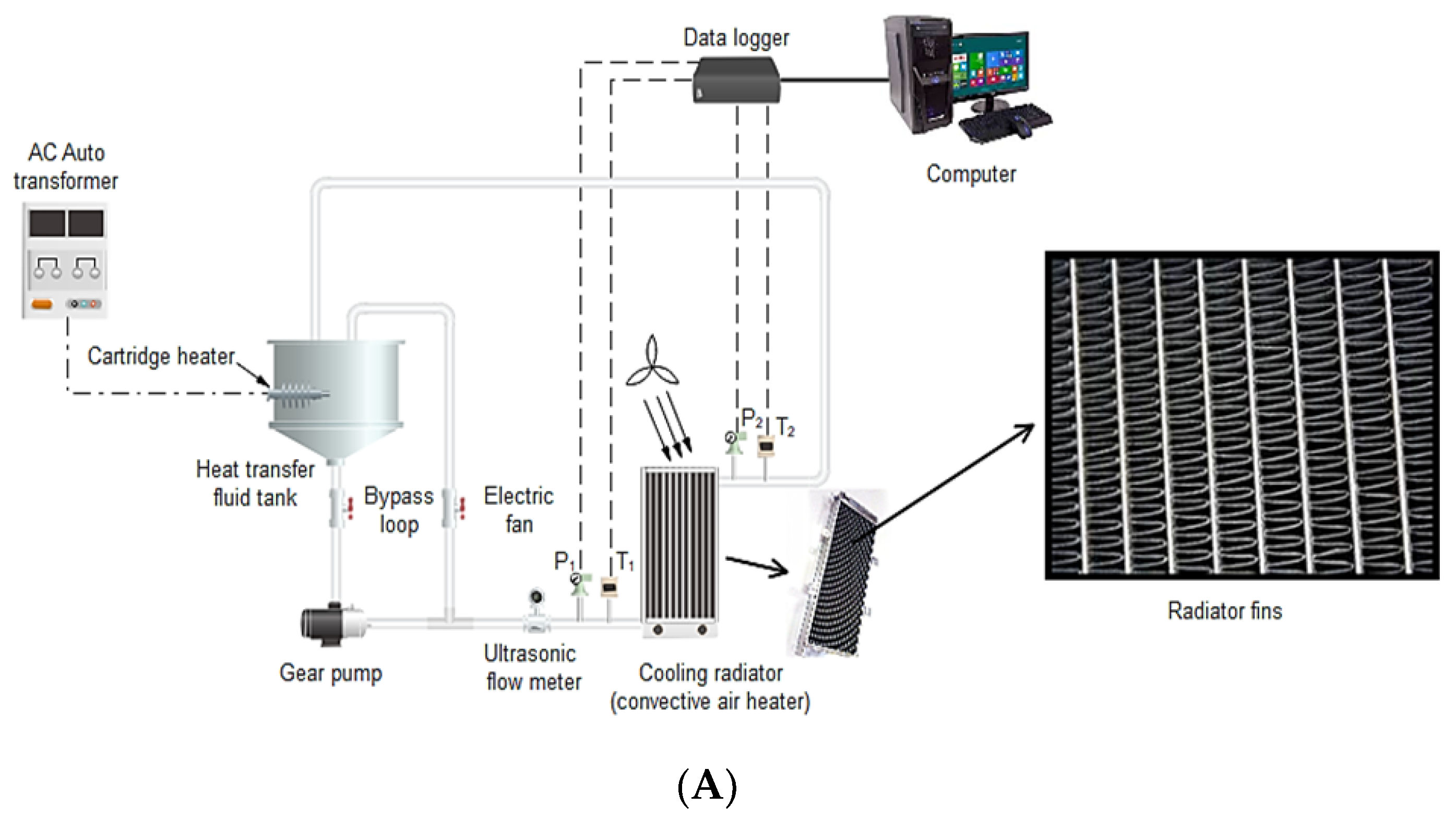
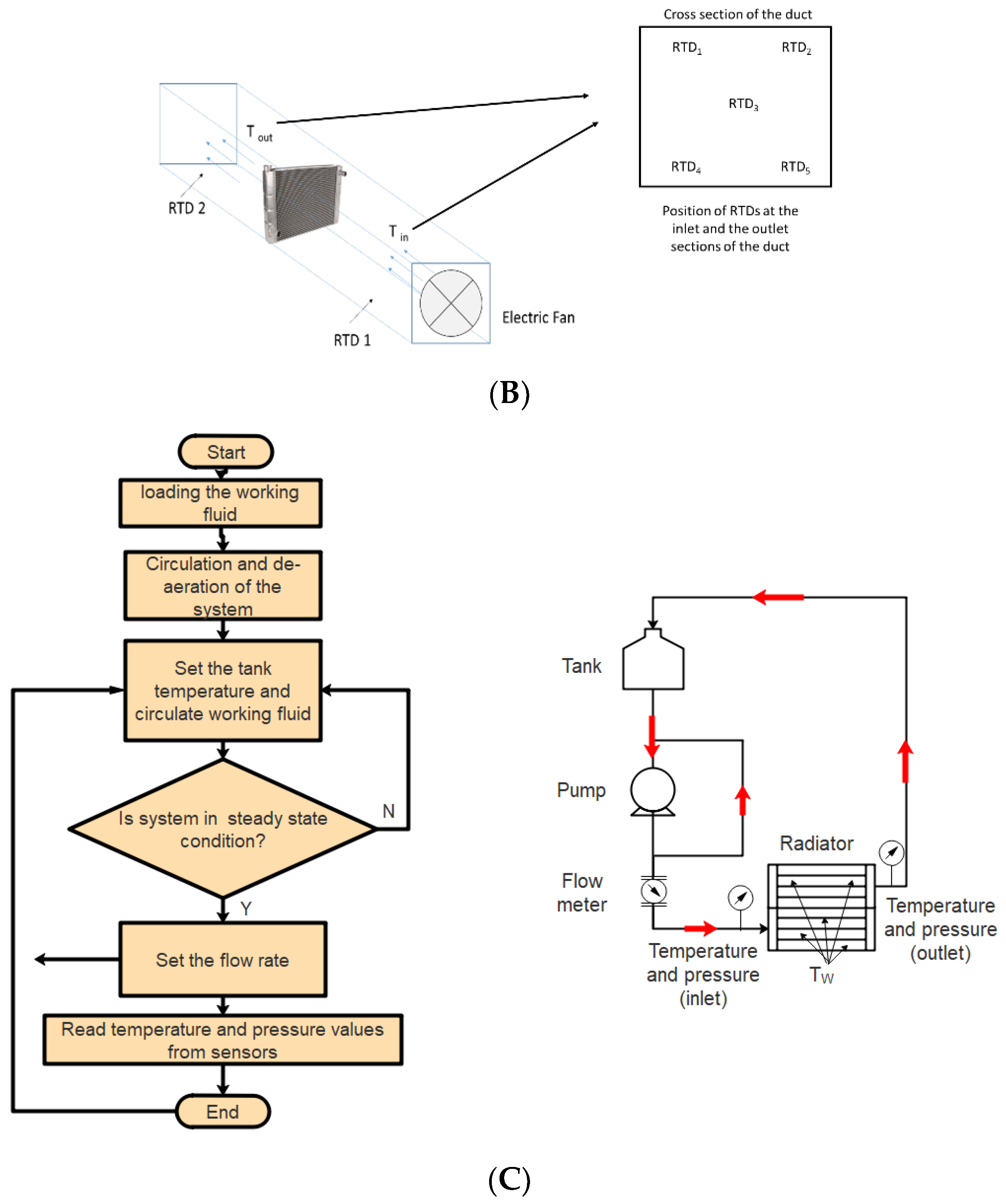
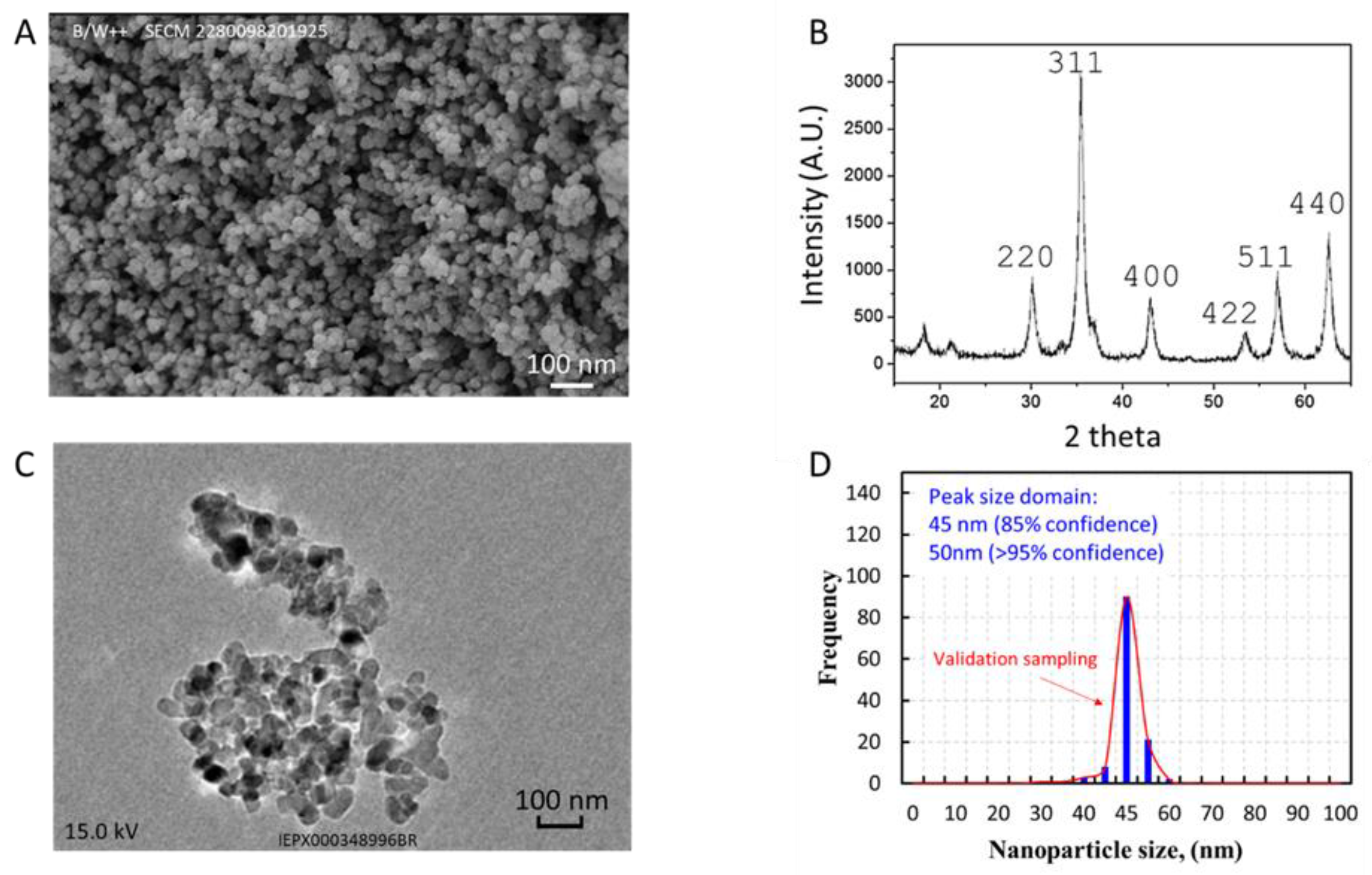
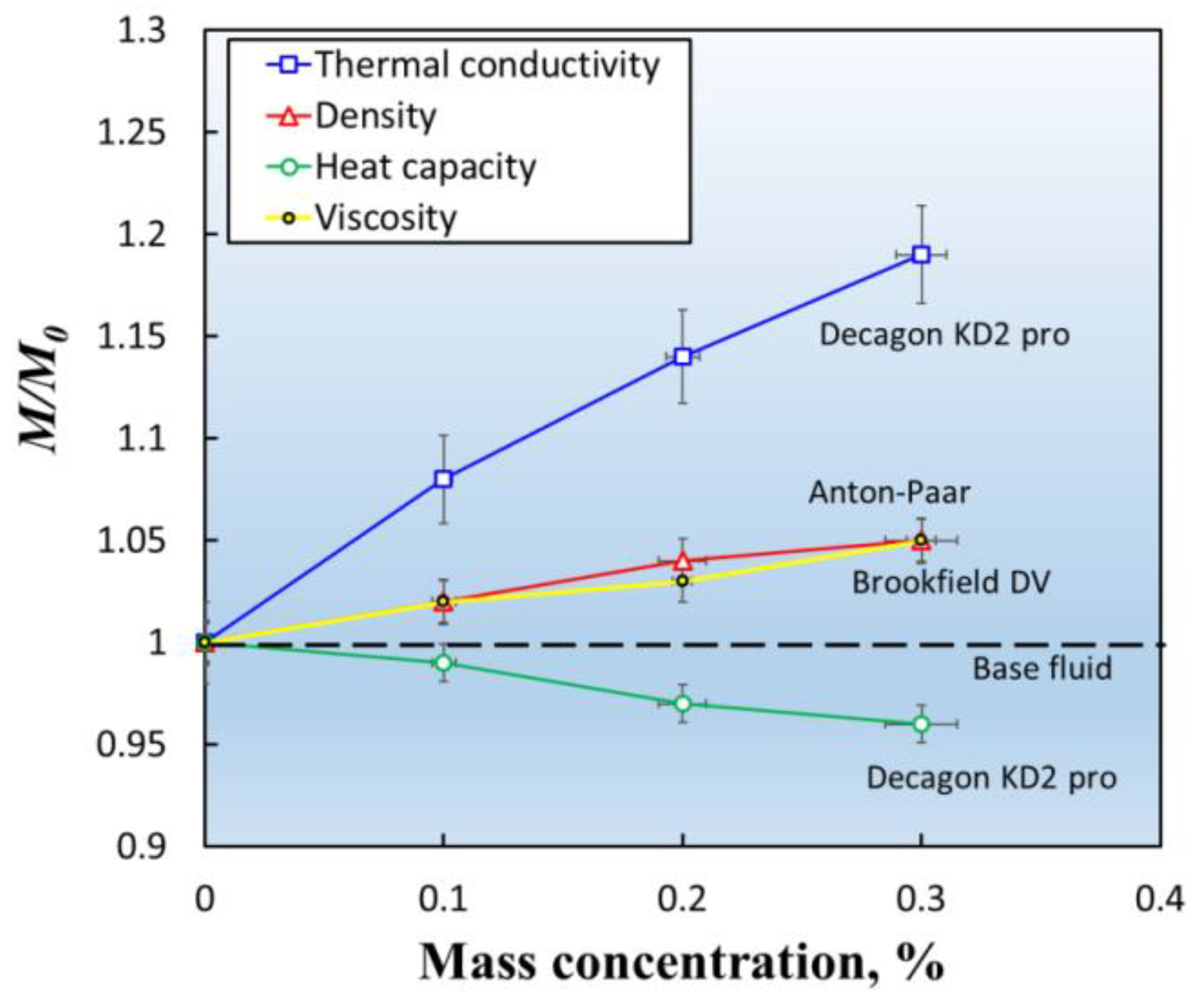
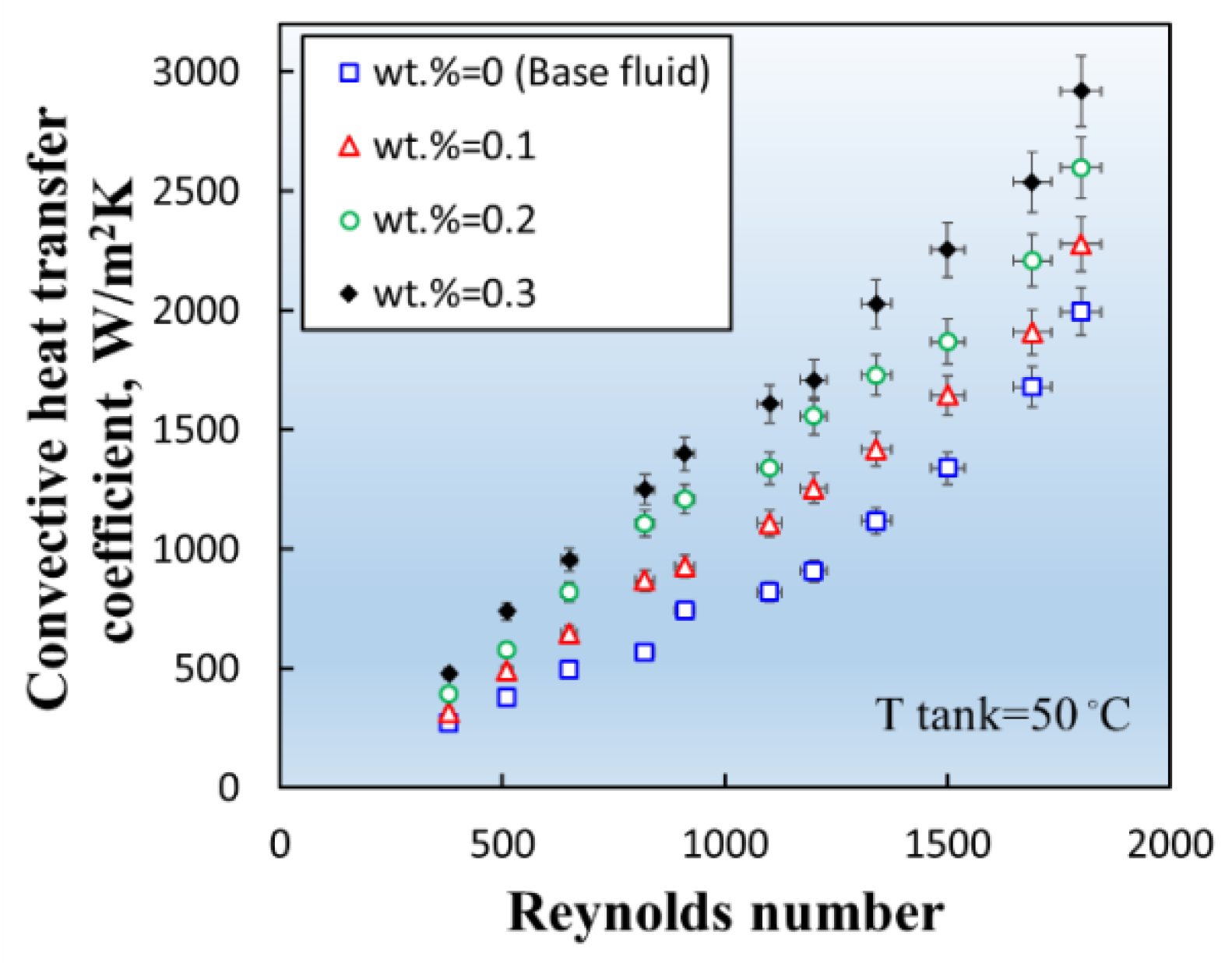

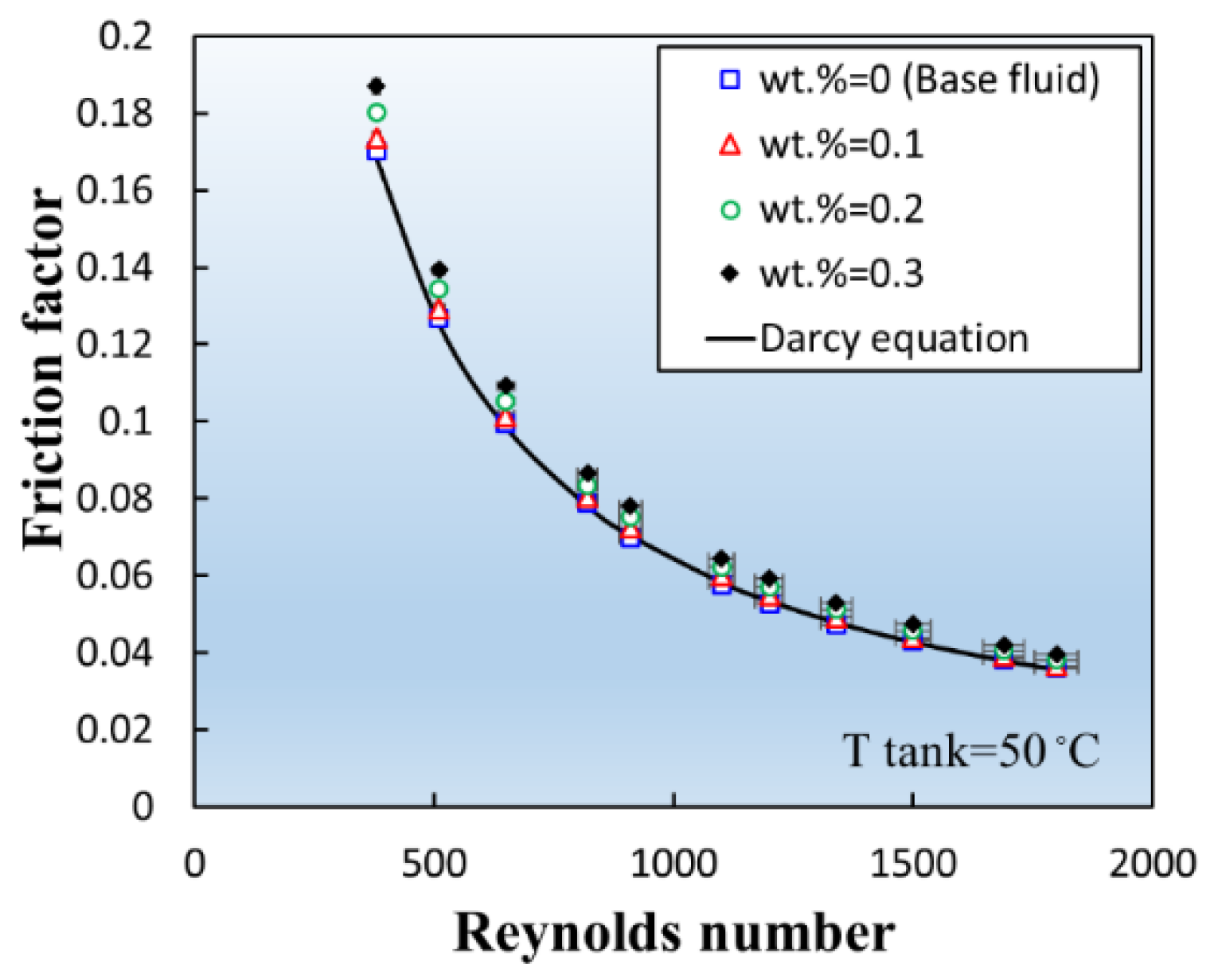
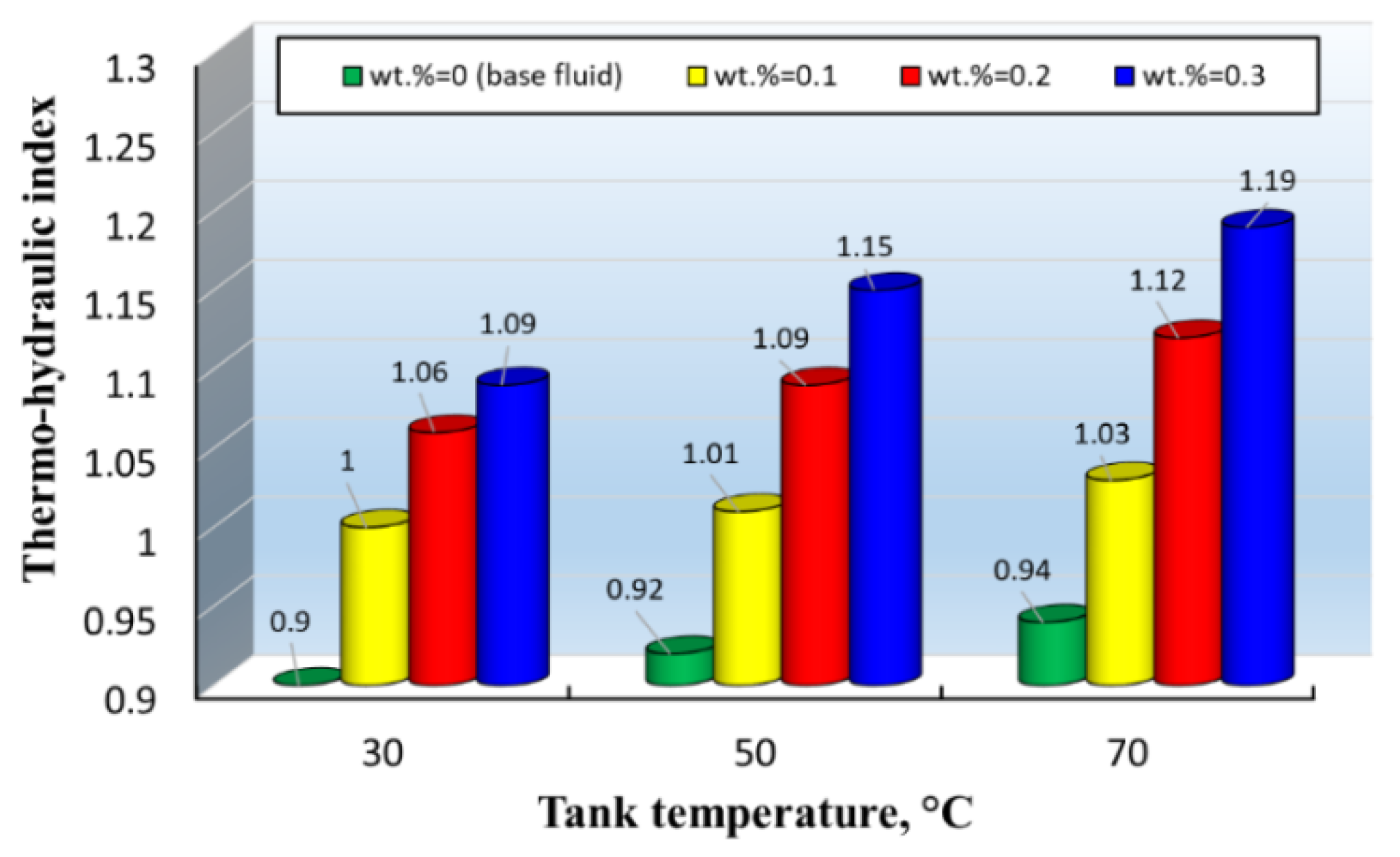
| Author(s) | Nanoparticle | Base Fluid | Concentration | Remarks |
|---|---|---|---|---|
| Kumar et al. [20] | Al2O3/MO | Mineral oil | 0.06 wt.% | Heat transfer enhanced by using the nanofluid in refrigerant R600a. 11.5% energy saving was achieved. |
| Firouzfar et al. [21] | Ag | Methanol | 100 mg/lit | Energy saving obtained was between 8.8 and 31.5% for cooling and between 18% and 100% for reheating. |
| Hatami et al. [22] | CNT SiO2 TiO2 | water | 0.001g nanoparticles in 3 L water | Results indicated SiO2/water nanofluid had better performance in energy saving. |
| Khalifa [23] | CuO Al2O3 | POE mineral oil | 0.1 wt.% | COP was enhanced for nanofluids containing CuO and Al2O3 up to 32.5% and 16.5%, respectively. Energy consumption was reduced by 16.6% and 10.1% for CuO and Al2O3, respectively. |
| Description | Value | Unit |
|---|---|---|
| Frontal area | 200 (H) × 350 (W) | mm |
| Coolant capacity | 12.9 | liter |
| Length of fin | 8.59 | mm |
| Fin thickness | 0.11 | mm |
| Fin pitch | 2.4 | mm |
| Fin type | corrugated | - |
| Heat transfer area/total volume | 890 (Air) 140 (Coolant) | m2/m3 |
| Number of tube passes | 35 | - |
| Spacing | 7.5 | mm |
| Hydraulic diameter (dual diameter) | 4.1–7.2 | mm |
| Parameter | Instrument | Accuracy/Uncertainty |
|---|---|---|
| Instruments | ||
| Liquid temperature | k-type thermocouple, Omega | ±0.5 K |
| Temperature of air | Thermo-meters, Omega | ±0.5 K |
| Air flow rate | Anemo-meter, Tucson | ±1% of max. displayed value |
| Liquid flow rate | Ultrasonic flowmeter, Flownetix | ±1% of max. displayed value |
| Flow rate | gear pump | ±0.1% of max. displayed value |
| Pressure | Pressure transmitter, Omega | ±1% of max. displayed value |
| Calculated uncertainty | ||
| Heat transfer coefficient | - | ±4.1% |
| Reynolds number | - | ±2.3% |
| Pressure drop | - | ±3.4% |
| Friction factor | - | ±2.6% |
© 2019 by the authors. Licensee MDPI, Basel, Switzerland. This article is an open access article distributed under the terms and conditions of the Creative Commons Attribution (CC BY) license (http://creativecommons.org/licenses/by/4.0/).
Share and Cite
Sarafraz, M.M.; Dareh Baghi, A.; Safaei, M.R.; Leon, A.S.; Ghomashchi, R.; Goodarzi, M.; Lin, C.-X. Assessment of Iron Oxide (III)–Therminol 66 Nanofluid as a Novel Working Fluid in a Convective Radiator Heating System for Buildings. Energies 2019, 12, 4327. https://doi.org/10.3390/en12224327
Sarafraz MM, Dareh Baghi A, Safaei MR, Leon AS, Ghomashchi R, Goodarzi M, Lin C-X. Assessment of Iron Oxide (III)–Therminol 66 Nanofluid as a Novel Working Fluid in a Convective Radiator Heating System for Buildings. Energies. 2019; 12(22):4327. https://doi.org/10.3390/en12224327
Chicago/Turabian StyleSarafraz, M. M., Alireza Dareh Baghi, Mohammad Reza Safaei, Arturo S. Leon, R. Ghomashchi, Marjan Goodarzi, and Cheng-Xian Lin. 2019. "Assessment of Iron Oxide (III)–Therminol 66 Nanofluid as a Novel Working Fluid in a Convective Radiator Heating System for Buildings" Energies 12, no. 22: 4327. https://doi.org/10.3390/en12224327








